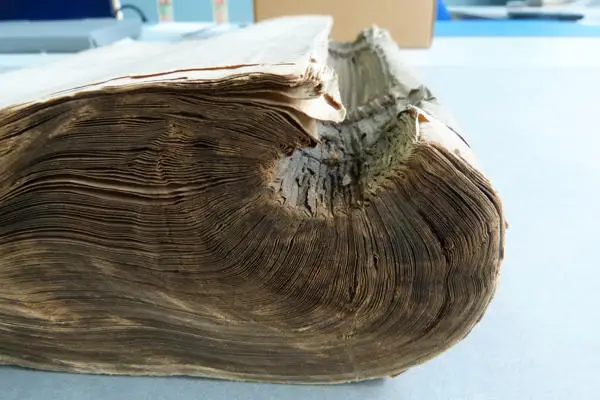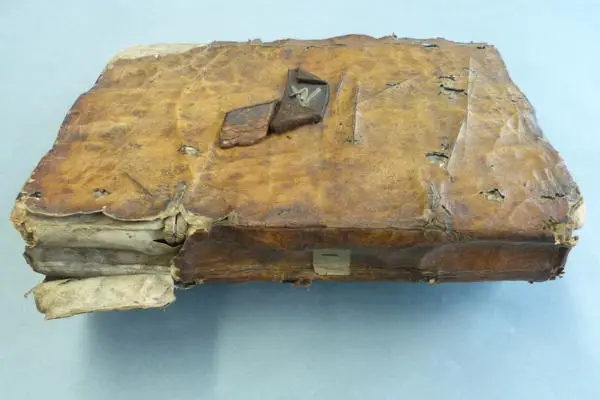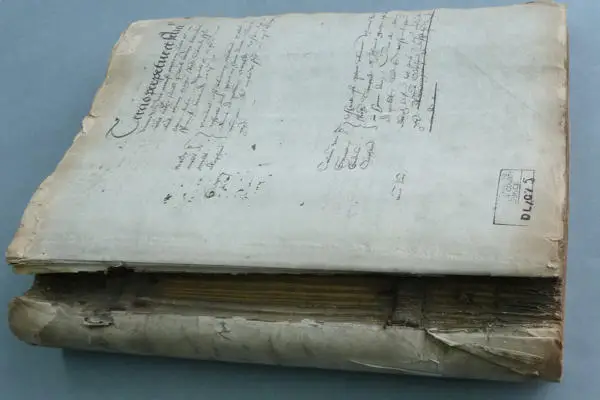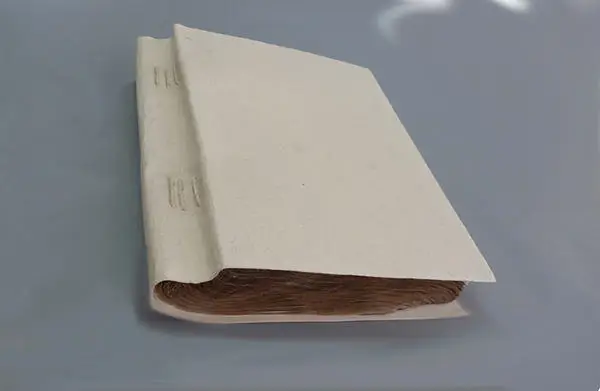Conservation in Action: Consistory Court of London volumes
Among the archives of the Diocese of London, LMA holds the records of the Consistory or Bishop’s Court (reference DL/C) including over 600 volumes recording its activities from the fifteenth to nineteenth centuries. The extent of the court’s jurisdiction varied over time, but for most of this period comprised the City of London, Middlesex and Essex, and the greater part of Hertfordshire.

The records of ecclesiastical courts are recognised as invaluable sources of information for social, legal, economic and ecclesiastical historians. In early modern England, ecclesiastical courts dealt with a wide variety of cases including church discipline, defamation, matrimony, testament and tithe cases. The Diocese of London records are especially rich as the court handled cases from a wide range of social classes across the diocese. The books are a comprehensive record of the business conducted by the court: the act books record the proceedings and outcome of cases; the deposition books record the testimony of plaintiffs, defendants and witnesses, and are an especially detailed source for daily life at the time. The books provide information about class, social, household and community relations, economic conditions, social and spiritual roles of the church, contemporary attitudes, events, legal knowledge and understanding, social and geographic mobility, marriage and inheritance practices, gender and relationships between the sexes.
In a period when the nation’s capital city was undergoing enormous growth and continuous change, the early modern London Consistory Court books provide a unique insight into the many spheres of activity over which the court had jurisdiction and all aspects of life at the time.
Conservation strategy
Owing to their rich content, the records are in high demand among users and frequently come up for consideration as part of LMA’s Access to Unfits programme. The importance of this collection also lies in the exceptionally large samples of original sixteenth and seventeenth century archival bindings, which represent a precious source of evidence for researchers of English and European bookbinding history.
In 2016 London Metropolitan Archives secured a grant from the National Manuscripts Conservation Trust to work on part of this collection. A survey was carried out to assess the physical condition of several damaged volumes. Out of 600 volumes 13, covering a period from 1467 to 1633, were selected as a priority (taking into account historical significance and research benefit), conserved and made available to the public.
One of the objectives of the 2016 project was to gain knowledge to inform the treatment of similar volumes in future. In 2019, owing to the popularity and exceptional nature of this material, it was decided to allocate part of the work of the Conservation studio to repair more DL/C volumes which were “unfit for consultation”. Prior to the conservation treatment, another survey was carried out, focusing on the first thirty oldest records, from DL/C/0001 to DL/C/0030. The survey collected data on the condition of the item, the required treatments and the estimated time to carry them out. Looking at the data, it was clear that the volumes required different levels of treatment: some needed a range of stabilising actions, while others required extensive treatments. Some volumes still had functional bindings in fair/good condition, while others were badly damaged. Most of the surveyed items were suffering from water damage along the edges of the textblock, making them difficult to handle without causing further damage. The aim was to prioritise the conservation treatments considering both the estimated time and the number of requests to consult these items by users.
Conservation treatment of two challenging volumes
Our conservator Giorgia Genco describes two volumes that were in poor condition and explains the different treatment solutions she chose to allow them to be accessed by readers again.
The first volume is an Act Book entitled 'Liber actorum habitorim in cons London…' dated from October 1496 to October 1505 (DL/C/0001). The volume is a full archival non-adhesive parchment binding. That means that the cover is attached to the textblock using some parts of the book structure. The textblock is made of handmade laid paper, it is handwritten with iron gall inks and is sewn on two double alum-tawed supports.

The volume overall was in fair condition. The binding and the sewing were almost intact and functional. The cover was splitting along the joint of the back board near the tail edge and had few tears along the fore edge. The main issue concerned the edges of the textblock, which were torn and affected by water damage in the past. This had resulted in fragility and softness of the paper, making the volume “unfit for consultation” as handling would have easily caused further damage.
The first step of the conservation treatment was to remove the surface dirt on each page by means of a latex vulcanised sponge. A soft brush was used on the areas where the writing support was more fragile. Then the edges of the textblock were consolidated with strips of light Japanese tissue adhered with wheat starch paste. The split cover was repaired with a strip of thick Japanese paper that functioned as a bridge between the spine and the back of the cover. Finally, the volume was housed in a box made of conservation grade cardboard.
The overall intention of the conservation treatment was to stabilise the damaged areas and allow access. This minimal intervention approach usually requires more time compared to a total makeover. This is because there are a lot of repairs to do to keep and use all the original features of the item. The treatment took approximately 45 hours.
The second volume is also an Act Book, dated from March 1547 to April 1551 (DL/C/0005).
The volume is sewn on two leather strips and the textblock is made of handmade laid paper, handwritten with iron gall ink.
The volume was in poor condition. The spine was heavily distorted and appeared extremely concave. The sewing was broken along the first section and the cover was missing. The textblock was suffering from extensive water damage, especially along the head and tail edges, where the paper was extremely soft and fragile.
There are many reasons for such spine distortions: here the leather strips had deteriorated because of natural decay, exacerbated by fluctuations of environmental conditions, such as temperature and relative humidity, causing the leather strips to shrink and stiffen. A residue of animal glue on the spine contributed to the spine distortion, adding stress to it.

After a careful assessment, it was clear that, despite the distortion, the book was still functioning well so it was decided to retain the existing shape. There was no need to take the volume apart; re-sewing it or trying to re-shape the spine and force it flat would have caused much more damage than leaving it as it was.
The first treatment step was to surface clean the textblock by means of a soft brush to remove the dirt. Then the residue of the old and rigid animal glue on the spine was removed by softening the adhesive with a poultice of methylcellulose and by scraping it away using a spatula. This greatly improved the flexibility of the spine and the opening of the volume.
The next step was to repair and extend the broken sewing support. The extensions were made by using two strips of pliester tape, a linen tape with a braided mesh, and linen thread; these were anchored on either side of each leather support. These new extensions were necessary to reattach the textblock to the cover.
The fragile edges of the textblock were consolidated with strips of light Japanese tissue and any losses were infilled with thicker Japanese paper. Wheat starch paste was used as adhesive.
Looking at the evidence and traces still visible on the volume, and at other examples from the same collection, it was clear that the original binding was an archival non-adhesive stationary binding. It was decided to provide a new cover and to attach it to the textblock without using any adhesive. The cover was attached to the textblock using cord strings (also called tackets) that were anchored on the sewing supports. The tackets were then laced through some holes previously pierced on the spine cover.

During medieval times covers were usually made of parchment, a durable material but prone to heavy distortions if kept in unstable environments. Therefore, to avoid potential stresses on the binding, it was decided to use thick natural flax gelatine sized handmade paper as it is less likely to distort compared to parchment. The main challenge was to mould the cover following the shape of the distorted spine. Local humidification with a natural sponge slightly soaked in water and patience did the job. Once the spine was moulded to the desired shape, the cover was then ready to be attached. Three pairs of holes aside each sewing support were pierced in the spine cover and the tackets passed through them and interweaved.
Finally, the volume was housed in a bespoke clamshell box made of conservation grade cardboard.